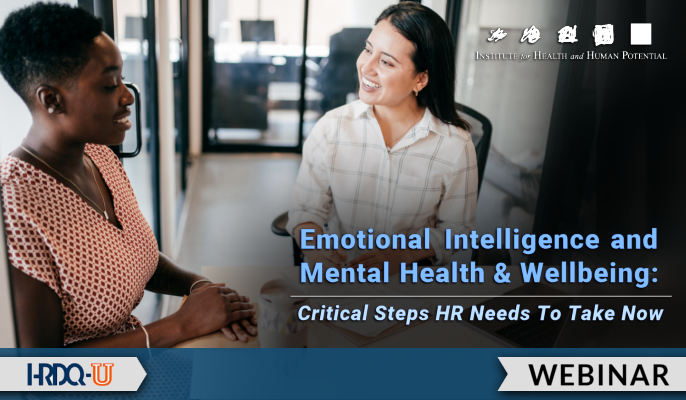- 827 Lincoln Ave. #B-10 West Chester, PA 19380
- support@hrdq.com
- +1-610-279-2002
Quick Links
Menu
Featured Topics
Menu
Total Results
We could not find what you're looking for. Please try again.No Record Found

This webinar originally aired in 2021. Some of the information and concepts presented in this event may no longer be relevant.
Over the past two years, the role and function of Human Resources have been disrupted – an ongoing pandemic, an almost overnight transition to more digital and distributed ways of working, and rising calls for more diversity, inclusion, and belonging, all posing significant challenges and opportunities for organizations. In this new uncharted territory, HR practitioners were immediately thrust into the spotlight and became the single most important function as organizations looked to them to help lead the way forward.
However, HR professionals have never faced this degree of challenge and change, nor have they received previous training to help them cope. Despite this reality, they have been running a marathon to develop systems and processes to keep their employees safe to ensure that their organizations survive, navigating furloughs, layoffs, and reductions in their workforce. HR professionals facilitated the massive movement to remote and hybrid work, engaged in strategic workforce planning, drafted emergency communications, developed coronavirus protocols to prevent spread in the office, and created and sustained an authentically inclusive culture.
The overwhelming majority of HR professionals choose their profession because they care about people and want to help and make a difference. That is why they continue to wear many hats in their efforts to help steer the ship while holding workplaces together. The responsibility of redesigning workplaces for resilience and recovery required the development of new skills, and the speed and depth of this change added a great deal of stress, pushing many HR professionals to the brink of burnout. The pressure of caring for people during these ever-changing times cannot be overlooked if organizations expect HR to continue leading the way.
The principle tenet of EI is “start with self.” HR professionals use themselves as vehicles in the development of others daily. This webinar will help HR professionals develop the essential human skills needed to feel supported, to successfully continue to provide resources, and to be the resource for leaders and their teams. This session will discuss how to make mental health and wellness a personal priority through these activities – engaging in self-compassion and self-care, leveraging EI skills to help alleviate stress, pressure, fear, and anxiety, and creating a personal practice to establish groundedness.
You’ve likely heard the quote, “Put the human back in human resources.” In this webinar, you will learn how HR professionals can develop the essential human skills of EI to move from being reactive to proactive, engage in self-reflection, build awareness before action, and pave the way for them to act as role models for others in the organization.


Dr. Cranla Warren, former Vice President of Leadership Development at IHHP.
A lifelong student of human behavior, Cranla holds a Ph.D. in organizational psychology and a post-graduate certificate in professional leadership. Cranla holds multiple graduate degrees across the disciplines of social work, philosophy, and psychology. As a psychologist, business leader, mental health practitioner, former psychotherapist, family therapist, coach, and mentor, Cranla has a wealth of knowledge and experience in the areas of mental well-being, emotional intelligence, organizational systems dynamics, values-based leadership, fellowship, coaching, women and leadership, diversity, equity, inclusion and belonging, and employee engagement.
As a leadership consultant, facilitator, and coach in private practice, Cranla interacts with leaders and HR professionals from many different sectors daily. She is seen as a trusted advisor and respected peer by those who hold formal roles in human resources, learning and development, leadership development, and talent development. With a focus on people development and the employee experience, she advocates that passionate and engaged employees are far more satisfied at work, leading to innovation, collaboration, and off-the-charts contributions. Cranla believes that a strong foundation of self-awareness, emotional literacy, and a focus on talent builds great leaders, fosters rich employee experiences, and creates great places to work.
Rhoda Lalog, Founder of Urban Consciousness.
Rhoda Lalog is a seasoned HR expert with over 20 years of practical and professional experience in the industries of telecommunications and banking. Her diverse HR career includes internal and external leadership consulting on recruitment, performance management, employee engagement, and employee relations, with specializations in health and safety, risk management, diversity, equity, and inclusion.
Rhoda’s lifelong fascination with human behavior inspired her academic background, which includes a certificate in early childhood education and a Bachelor of Arts degree in sociology and communications. She is currently licensed as a registered psychotherapist (qualifying) in Ontario, practicing a holistic model of psychotherapy with an area of focus on leaders and entrepreneurs. Her passion for understanding the inner workings of our minds from childhood to adulthood, in the context of our social settings, has been the key motivator that continues to inform her career path.
Today, she combines her working knowledge as a therapist with decades of HR leadership insights to bring humanity back into the function of Human Resources. She is passionate about building the capacity of organizations to foster a safe and inclusive environment that places a focus on the mental and emotional wellbeing of individuals.
Institute for Health and Human Potential offers Instructor-led and Digital learning that equips your people with the skills to have tough conversations, make difficult decisions, and meaningfully connect. They help your people build the skills required to work and lead courageously in the Last 8%. The Last 8% are the tough conversations, difficult decisions, and opportunities to meaningfully connect that people avoid because emotions get in the way. IHHP built a methodology in the teaching of these skills with life-changing results to Olympic and professional athletes, hundreds of blue-chip companies, including Goldman Sachs, Intel, IBM, and many government agencies, including the US Marines and NASA.
Learn more at www.ihhp.com

“Great webinar! The issue of mental health, despite the pandemic, is still an issue that most employers struggle with addressing or even admitting is an issue. Very helpful speakers and content.”
Nathan K.
Case Manager
Gateway Community Action

“Dr. Warren and Ms. Lalog were authentic, knowledgeable, and relatable to real workplace situations and human experiences regarding COVID and how Emotional Intelligence is critical for positive impacts and outcomes. I enjoyed the webinar tremendously! Thank You!”
Rhonda T.
Branch Chief
USDA Forest Service

“This was one of the best and more informative webinars I’ve attended recently. The title and content matched, and it provided great insight to understand not only from an educational perspective, but from a personal insight and emotional intelligence capacity as well!”
Tory T.
Director of Supplier Operations
4imprint

Sign up to be notified of upcoming live webinars, in-depth workshops, podcasts, blog posts, promotions and much more. Stay ahead of the curve and subscribe for FREE today!